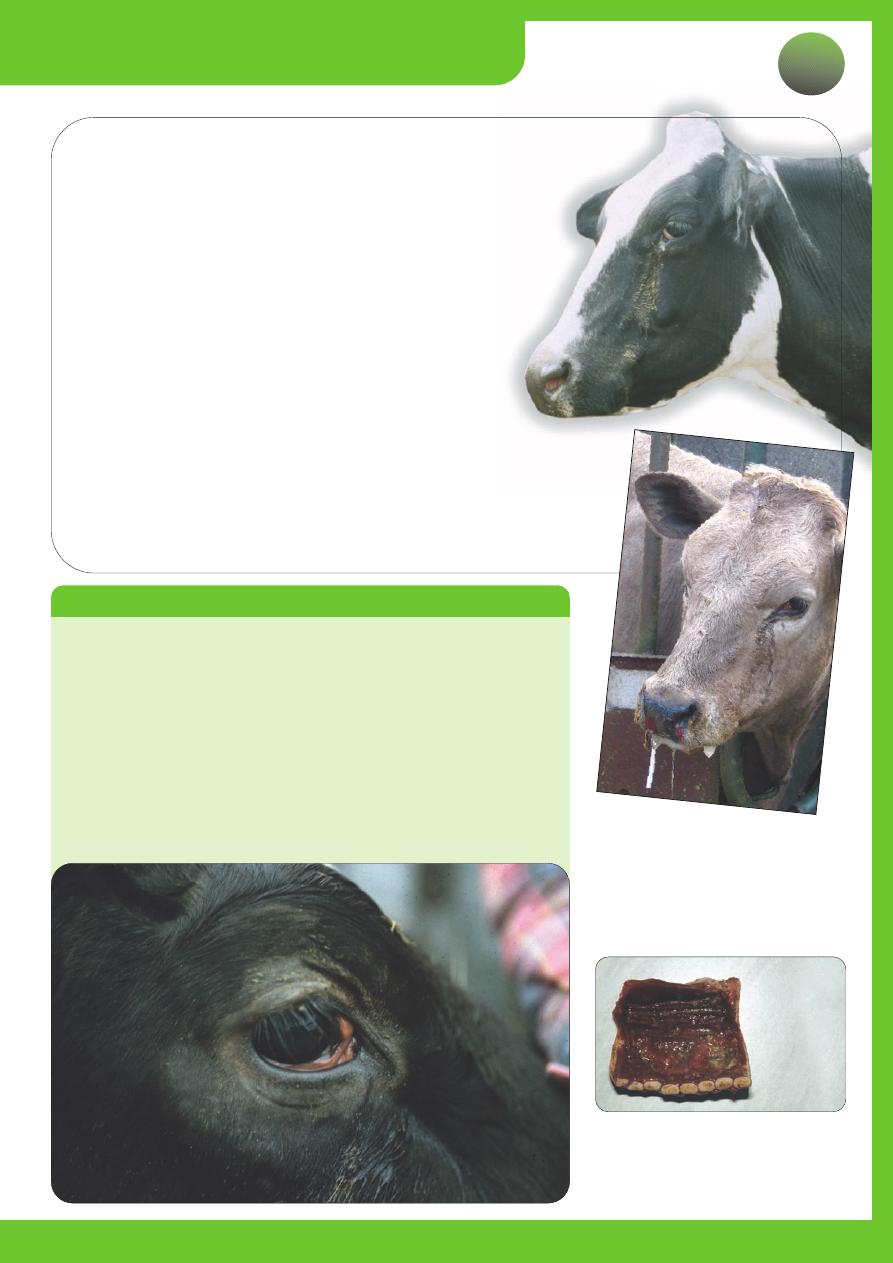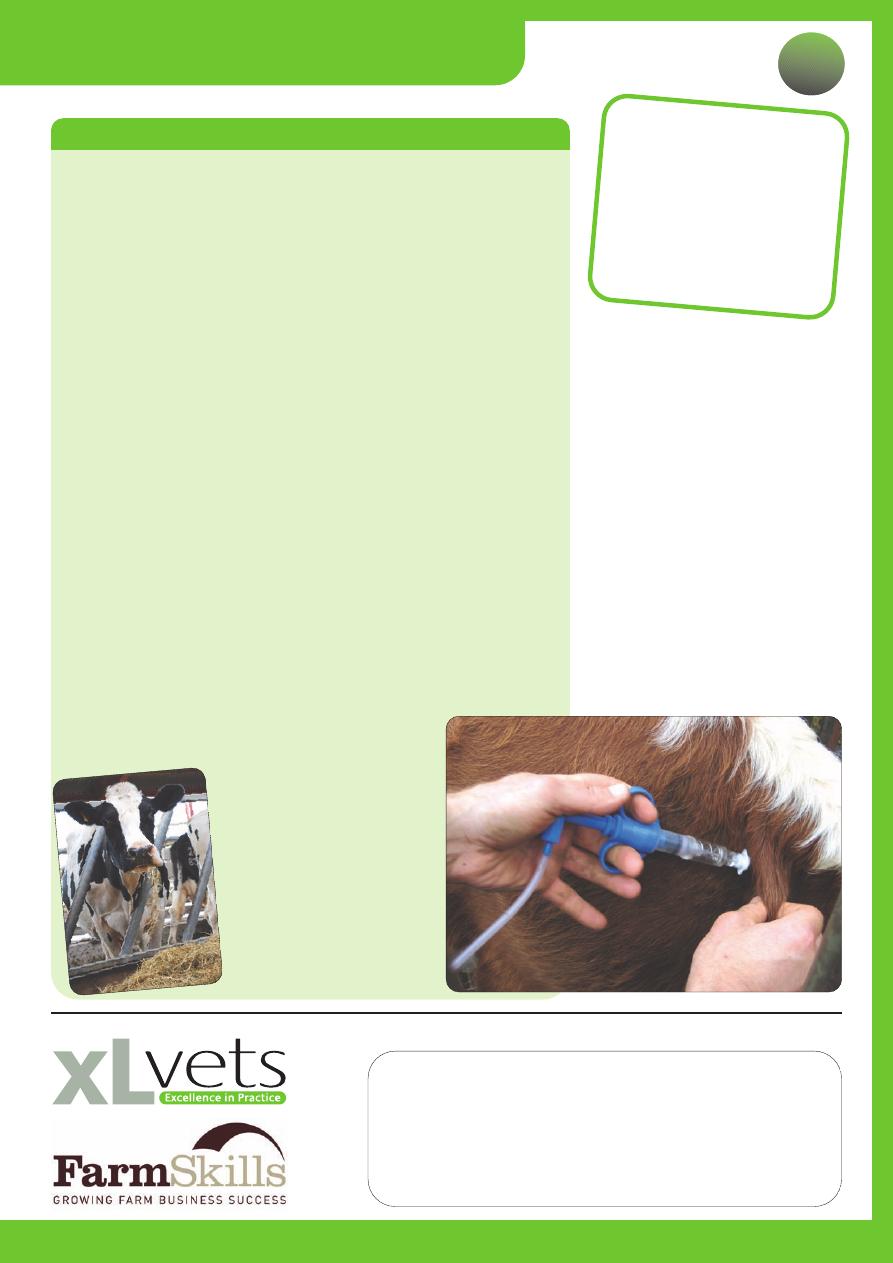
XLVets Fact Sheet
XLVets Committed to UK farming
The classic signs of clinical IBR
include:
●
A high temperature.
●
Roaring respiration.
●
Coughing due to inflammation
and damage within the upper
airways.
●
A red, crusty nose with a
variable but often thick, pussy
discharge.
●
Red, runny eyes.
The severity and number of these
signs can vary widely and they are
not all always seen.
The disease can progress to a
severe pneumonia if debris from
the inflamed upper airways is
inhaled.
If you spot symptoms or sense
there is something not quite right,
call in your vet as early as possible
and find out what your IBR status is.
CLINICAL SIGNS
Infectious Bovine
Rhinotracheitis
IBR
IBR is the most obvious clinical disease associated
with infection by Bovine Herpesvirus 1 (BoHV-1).
IBR is a disease of the upper respiratory tract
which varies in severity, depending on the strain
of virus involved and other factors which may
influence the immune status of the animal. In severe
cases, damage to the upper airways may lead to
pneumonia and sometimes death. BoHV-1 infection
has also been associated with infertility, abortion,
high temperatures and milk drop.
Red, runny eyes.
Cross section
of damaged
airway caused
by necrotising
tracheitis.
Infectious /
Parasitic diseases
IIP
P
TREATMENT
Non-steroidal anti-inflammatory drugs
(NSAIDs) are perhaps the most
important part of IBR treatment as
they minimise the damage to the
upper airways and make the affected
animals feel better.
Broad spectrum antibiotics are also
often given to protect against
secondary bacterial infection.
Nursing should not be forgotten.
02/2014

XLVets Committed to UK farming. Go to www.xlvets.co.uk
XLVets IBR
Most animals infected with BoHV-1, assuming they recover,
remain latently infected for life. The latent virus can be
reactivated at any time, usually precipitated by stress, to
spread and cause more disease.
Managing stress is important in controlling IBR. When housed, animals
should be kept at an appropriate stocking density in well ventilated, dry
buildings. Access to good quality food and water should be ensured and
other infectious disease, particularly BVD, should be controlled.
Vaccination can play a useful role in the control and prevention of IBR.
Many different vaccines, both live and dead are available to protect
against disease and the choice of which to use should be made carefully
following discussion with your vet.
Whichever vaccine is chosen, it is important that it is administered carefully
in accordance with data sheet recommendations if it is to be effective.
Marker Vaccine The use of ‘marker’ vaccines allows laboratory testing to
be used to distinguish antibodies raised as a consequence of vaccination
from those raised following challenge by the disease. It is important to
recognise that vaccination with a marker vaccine will not prevent
antibodies being formed against field-strain virus if a challenge occurs.
Biosecurity Herds free of BoHV-1 infection and those trying to remain
free of infection must pay attention to biosecurity, particularly when
animals are introduced onto the farm. Farm boundaries must be secure
to prevent nose-to-nose contact with neighbouring animals of unknown
health status.
Testing When testing quarantined animals for the presence
of antibodies to BoHV-1, all animals that test positive
should be assumed to be latently infected with the virus.
It is also important to recognise that not all latently
infected animals have detectable antibodies to the virus.
Vaccination and biosecurity
protocols need particularly
careful consideration in
herds planning to breed
animals either for export
or to go to stud. See the
XLVets biosecurity fact
sheet on the XLVets
website for further advice
and talk to your vet.
VACCINATION PROGRAMME
Maintaining animal health is essential
if dairy and beef enterprises are to be
successful. A vaccination programme
is an important part of this health plan.
Certain questions need to be
answered before a vaccination
programme can be planned including
why vaccination is required, what is
the aim of vaccination programme,
what vaccine should be used, when
and how? Vaccination programmes
should be customised for your farm
and incorporate cows, bulls, calves
and heifers.
For best results work in partnership
with your vet to monitor herd status
and to put in place your farm’s
individual vaccination programme.
For further information contact your local XLVets practice:
IBR is caused by a virus,
one of the Herpes family
,
which also contains the
virus that causes cold
sores in humans.
The
virus is called
Bovine
Herpesvirus 1,
also
known as BoHV-1.
Infectious /
Parasitic diseases
IIP
P
PREVENTION AND CONTROL
Photo Courtesy of Sterimatic
